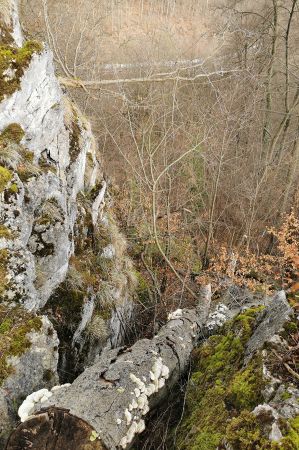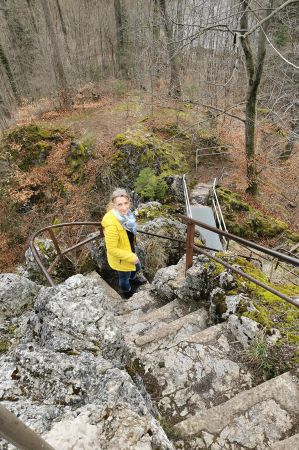Encountering the Hübichenstein near Bad Grund
- Written by Portal Editor
A legend that is known far beyond the Harz Mountains reports that the Hübichenstein near Bad Grund was the home of dwarfs, gnomes and elves in the past:
The dwarf king Hübich was therefore the lord of the limestone rocks. Hübich is described as an old man of short stature with coarse hair and a beard that reached to his stomach. The legend wants to know that the magic power of the dwarf was also in this beard. The kind and kind-hearted ruler often gave silver pine cones to the poor of the region. However, people were forbidden from entering his realm. Violations of this ban are said to have been severely punished by Hübich and the sinners arrested. During the Thirty Years' War, the top of the limestone cliffs was shot up by some soldiers. After that, Hübich was never seen again.
Legend and reality today - a tourist attraction despite mining
 Actually, the Hübichenstein is "only" a limestone rock with two connected rock needles, which are left as towering remnants of the Harz coral reef.
Actually, the Hübichenstein is "only" a limestone rock with two connected rock needles, which are left as towering remnants of the Harz coral reef.
Hard to imagine today that the Harz was once below sea level.
Of the needles, however, only the higher one, which rises almost 50 m above the surrounding area, is usually associated with the Hübichenstein, the second needle serves more or less only as a transition with its carved steps and the metal bridge to the higher needle.
 The crags of the Hübichenstein, as well as other large parts of the Harz mountains, are the remains of coral reefs.
The crags of the Hübichenstein, as well as other large parts of the Harz mountains, are the remains of coral reefs.
They consist mostly of reef carbonate rocks of the Upper Middle Devonian Givetian and are also mined industrially in large quantities, as can also be observed a few hundred meters away. The limestone belongs geologically to the limestone of the nearby Iberg.
This becomes clear, among other things, from the fact that here, as on the Iberg, nested feldspar and limonite deposits are present.
For this reason, there are also some pings under the Hübichenstein. Smaller caves can also be found in its limestone and only a few hundred meters away is probably the most striking cave, the Iberg stalactite cave.
Eagle figure commemorating Sedan Day
 In 1895, a committee chaired by Mayor Spatzier in Bad Grund was formed to erect a monument to Kaiser Wilhelm I (1797–1888) on the legendary Hübichenstein to mark the 25th anniversary of the so-called “Sedan Day”.
In 1895, a committee chaired by Mayor Spatzier in Bad Grund was formed to erect a monument to Kaiser Wilhelm I (1797–1888) on the legendary Hübichenstein to mark the 25th anniversary of the so-called “Sedan Day”.
The Battle of Sedan took place on September 1st and 2nd, 1870 during the Franco-Prussian War in Sedan, a town in the Ardennes department in what is now the Grand Est region. The city is near the Franco-Belgian border on the banks of the Meuse. The German victory of its time was decisive for the outcome of the war. On the French side, the capitulation of the French troops and the capture of Emperor Napoléon III. the proclamation of the Third Republic.
To celebrate this day, a two-meter-high medallion image of the emperor, created by the sculptor Georg Wilhelm Bode from Wilhelmshütte, was to be mounted on the towering rock, framed by laurel branches and the imperial crown above. In 1897 a mighty eagle with a wingspan of three meters was placed on the top of the rock. The anniversary of the Battle of Gravelotte on August 18, 1897 is considered the day the monument was completed. The Louis Sievert foundry in Bad Grund carried out the casting of the relief and eagle. The total costs amounted to 1,512.64 marks, which were raised through voluntary donations from the citizens of Bad Grund.
 In the later German Empire, "Sedan Day" was celebrated on September 2nd as a patriotic holiday in place of a national holiday that did not yet exist. On August 27, 1919, the Ministry of the Interior of the Weimar Republic announced that there would be no more sedan celebrations. Before that, Sedan Day was primarily a holiday for the bourgeoisie loyal to the emperor, the nobility, the military, Prussian civil servants and the rural population, but hardly any of the workers.
In the later German Empire, "Sedan Day" was celebrated on September 2nd as a patriotic holiday in place of a national holiday that did not yet exist. On August 27, 1919, the Ministry of the Interior of the Weimar Republic announced that there would be no more sedan celebrations. Before that, Sedan Day was primarily a holiday for the bourgeoisie loyal to the emperor, the nobility, the military, Prussian civil servants and the rural population, but hardly any of the workers.
The monument did not long survive the monarchy in Germany, it was vandalized. Only the eagle has survived to this day.
Please also read:
Harzer hiking needles - one system prevails!
Rentina Castle - Roman Via Egnatia towards Kavala
-
 Hübichenstein next to Bad Grund
Hübichenstein next to Bad Grund
Hübichenstein next to Bad Grund
Hübichenstein next to Bad Grund
-
 Hübichenstein next to Bad Grund
Hübichenstein next to Bad Grund
Hübichenstein next to Bad Grund
Hübichenstein next to Bad Grund
-
 Hübichenstein next to Bad Grund
Hübichenstein next to Bad Grund
Hübichenstein next to Bad Grund
Hübichenstein next to Bad Grund
-
 Hübichenstein next to Bad Grund
Hübichenstein next to Bad Grund
Hübichenstein next to Bad Grund
Hübichenstein next to Bad Grund
-
 Hübichenstein next to Bad Grund
Hübichenstein next to Bad Grund
Hübichenstein next to Bad Grund
Hübichenstein next to Bad Grund
-
 Hübichenstein next to Bad Grund
Hübichenstein next to Bad Grund
Hübichenstein next to Bad Grund
Hübichenstein next to Bad Grund
-
 Hübichenstein next to Bad Grund
Hübichenstein next to Bad Grund
Hübichenstein next to Bad Grund
Hübichenstein next to Bad Grund
-
 Hübichenstein next to Bad Grund
Hübichenstein next to Bad Grund
Hübichenstein next to Bad Grund
Hübichenstein next to Bad Grund
-
 Hübichenstein next to Bad Grund
Hübichenstein next to Bad Grund
Hübichenstein next to Bad Grund
Hübichenstein next to Bad Grund
https://www.alaturka.info/en/germany/lower-saxony/6032-encountering-the-huebichenstein-near-bad-grund#sigProId8416c04642

